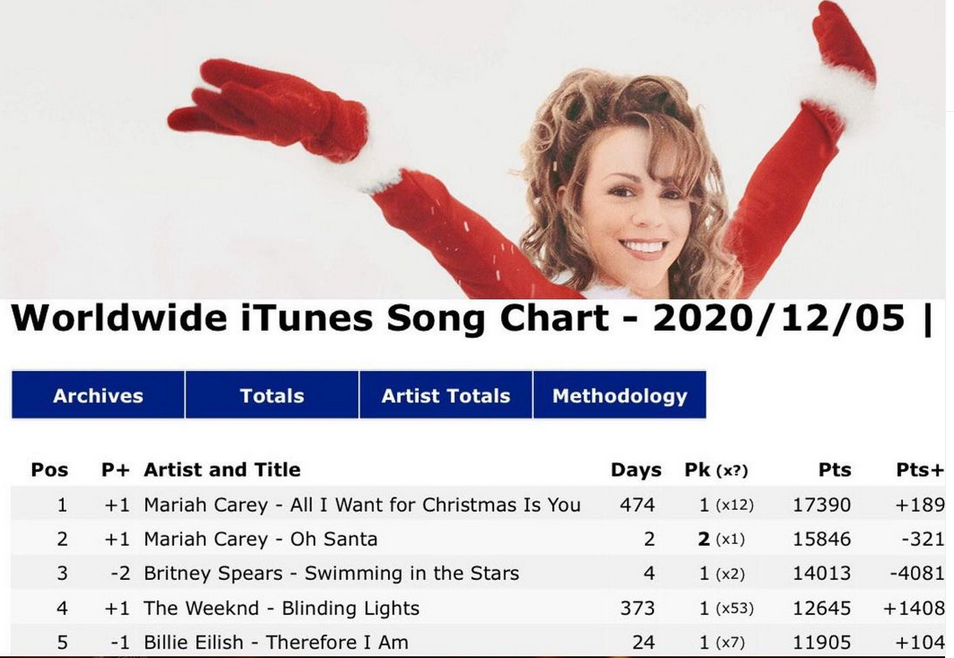Analysis from Steve Ahern
Two events this week have put a spotlight on the way the music industry business is evolving.
Bob Dylan has sold the copyrights for his entire portfolio of songs, a lifetime’s work, to Universal Music, for hundreds of millions of dollars.
Mariah Carey’s song ‘All I want for Christmas’ has hit the top of the iTunes and Spotify charts, 18 years after it was published. The Youtube video of the song, published last year, has had 88 million plays.

This signals a big change in how the music industry makes money in the age of ‘rented’ music through streaming services. Back catalogues have become valuable again.
In the old days, before digital disruption to the music industry, the commercial value of an artist was judged by their ability to keep churning out songs to keep them fresh with fans and maintain sales of new albums. In those days, the artist’s main value came from the price of their most popular current album.
Now the value of each song comes to the artist and the record company any time the song is played on a streaming service. Continuous micropayments add up, and may, in the long run, be more lucrative for musicians than the old music busines model.
For more evidence that the whole music business model is being turned on its head, just look at the revival of the Fleetwood Mac 1977 hit Dreams, which was featured in a TikTok video in October, causing the 4 decades old song to spring back into the charts and excite a whole new generation of people who had never heard it before.
@420doggface208 Morning vibe ##420souljahz ##ec ##feelinggood ##h2o ##cloud9 ##happyhippie ##worldpeace ##king ##peaceup ##merch ##tacos ##waterislife ##high ##morning ##710 ##cloud9
It inspired Stevie Nicks to reprise the hit in her own version on TikTok too.
After the TikTok video was released, streams of the track doubled from a daily average of about 49,000 plays to 105,000 per day. Sales of the song also increased 184% in the first three days of the TikTok video being posted. Streaming numbers saw a 242% increase in first-time listeners to the song.
Now, just being new is not necessarily the only way to get value from your music. Being good and being noticed is also important in the new world of ‘rented’ music collections on Spotify, Pandora and other music streaming services.
Old songs can be just as valuable to copyright owners as new songs, which is a new paradigm for musicians and music companies.
If a song can be surfaced on social media or because it has a key word like Christmas in it, it can make money for the artist no matter how old it is.
How many people will be asking their smart speaker for Christmas songs in coming weeks? Artificial intelligence, combined with search, will deliver those songs to the listener, as well as a royalty for each play, from back catalogue Christmas collections.
A lot is changing in the music business. Some time ago, musicians and record companies discovered that they now make more money from live performances than album sales, and adapted to that. Now it is becoming clear that a good song is a good song no matter when it was written, or a topical song that is worth reviving every year on a certain anniversary, could make just as much money as a new top hit.
What are the implications of this for radio?
Greatest hits formats may find themselves back in fashion again, as long as their music universe is full of great timeless songs with excellent musicianship, discarding those one-off disposable hits that were popular for a time, but do not have the quality of lyrics or music to make them timeless.
Contemporary Hit Radio (CHR) formats may not be the licence to print money that they once were if they only concentrate on what is new rather than what is good.
Music Directors will need to be open to rediscovering old music that is still relevant, as well as discovering new music. And they will have to search on all the social media platforms, particularly TikTok, to see what is trending in the zeitgeist, not just wait for a bunch of new releases to drop on their desk or into their inbox.
Themed shows and related playlists that transcend the decades to find the best mix of songs about a topic or holiday season may become fashionable again as music from any era surfaces via social media or non-specific requests like ‘play me Christmas music,’ ‘play me happy music,’ or ‘play me party music.’
Good music is timeless.
The changes taking place in the music industry look likely to reward musicians and publishers who make great music. Music Directors will need to think carefully about how to best incorporate these new trends into the decision making about what they put onto their radio stations, podcasts and branded playlists.
About the Author
 Steve is Head of the Asia Pacific Broadcasting Union Media Academy and founding editor of this website.
Steve is Head of the Asia Pacific Broadcasting Union Media Academy and founding editor of this website.
He is a former broadcaster, programmer, senior executive and trainer, and a regular writer and speaker about trends in media.
More info here.
Subscribe to the radioinfo podcast on these platforms: Acast, Apple iTunes Podcasts, Podtail, Spotify, Google Podcasts, TuneIn, or wherever you get your podcasts.





The author makes valid statements about contemporary music formats and greatest hits formats.
First, if you think about contemporary formats over the decades, one could describe them as CHR of their day. Top 40 radio formats of yore on 2UE, 2SM and 2UW were the CHR of their day. Particular tunes were in high rotation. The time window for playing past hits may have been limited to a decade.
SImilarly, the CHR formats of today will play only hits within a few years of their release. However, today's CHR is more than the rock and roll genre. These formats may consist of rock, dance, easy listening. Even with the diversity of genres, CHR may well consist of 'hits' released within the last few years. To illustrate, if we think of 2UW, MIX106.5 (callsign 2UFM) and KIIS106.5 (callsign 2UFM), apart from the time 2UW was momentarily a 'classic hits' format, the station (2UW, Mix and KIIS) was CHR: that is anything beyond a few years was 'discarded'. The same could be said about WS-FM, CHR with little 'classic hits'.
The artists on CHR may well be new or 'old' where the 'old' artist can perform new contemporary hits.
Even when there are new artists coming into the CHR, the formats don't allow for other genres. For example I have an album of music by the artists Emma Pask and Tom Burlinson accompanied by a big band, but don't hear that on mainstream radio. The same could be said about Josh Groban, Mark Vincent even Robbie Williams. It is ironic that these artists were given airtime on a spoken word station such as 2GB..
Second, when it comes to 'classic hits' "...their music universe is full of great timeless songs with excellent musicianship, discarding those one-off hits..." while hits in their own right. Unfortunately, some stations regards certain tunes and play them in high rotation.
There is nothing wrong with these artists and songs, I like them. But these narrow list of songs are not their only 'hits' Give these songs a rest and not play in high rotation.
* Bob Seeger, "Old Time Rock N' Roll"
* Creedence, "Proud Mary", why not play "Who'll Stop The Rain" or "Lodi" to name a few.
* John Cougar and variations to his name, "Cherry Bomb". It is not the only song from the album "The Lonesome Jubilee". Why not play "Paper in Fire"
* Phil Collins, "Sussudio", . Why not play "Two Hearts", or other songs at https://www.ilikeyouroldstuff.com/news/phil-collins-biggest-hits-in-australia
* James Blunt, "Beautiful" beautiful lyrics at the beginning, but the annoying repetition of "....you're beautiful..." with a C, A-min, F and G or equivalently transposed chords. Replace with Christine Aguillera's "Beautiful" - it is beautiful music.
Then you have to consider that just because the song is a 'classic hit' may be new to someone else of a similar demographic. I strongly doubt that people will remember all the hits of the listener's memory. Thus a 'classic hit' may well a new song.
Examples of hits with no airplay to name a few:
* Al Kooper and Stephen Stills, "It Takes A Lot To Laugh, It Takes A Train To Cry"
* Reparata, "Captain Of Your Ship"
* UK Beat, aka The Beat aka The English Beat, "Can't Get Used To Losing You"
* The Isley Brothers, "Behind A Painted Smile"
* The Delfonics, "Ready Or Not Here I Come (Can't Hide From Love)"
* Liv Maessen, "Snowbird", "Knock Knock, Who's There"
* Jeff St. John, "Teach Me How To Fly"
* Max Merritt with or without The Meteors, "Slipping Away", "Dirty Work", "Proud Mary", "Hush" (instrumental).
* The Strangers, "Mr President"
* Charles and Eddie, "Would I Lie To You"
* Karen Ramirez, "Looking For Love"
* David Guetta and Rihanna, "Who's That Chick"
These songs regardless of one's demographic may well be new to them.
Then even if they even if the songs were not hits, they sound good.
Thus the author is correct that "...Music Directors will need to be open to rediscovering old music...."
At the same, as I have mentioned before, there is a plethora of "classic hits/golden oldies/hits-and-memories" type stations.
By music directors rediscovering old music, may add variety to the "classic hits formats".
Furthermore, what has been missing from airplay are familiar songs from movie musicals. These songs may provide a sing-along break from the rest of the playlist. Even short classical pieces of four minutes from composers such Mozart, Chopin, Beethoven and Strauss to name a few would blend well with other music provided the music directors are not tone deaf.
A final note, my music tastes are neither CHR nor 'classic hits' nor 'classical music' nor jazz nor 'elevator music' (as the old 2CH). I have my own 'mix' of many genres on mp3 which are not satisfied by listening to a particular station. It's a variety of musicianship, rhythms and melodies.
It is rare for me to listen to music radio.
Thank you,
Anthony of critical Belfield
For me, I rarely listen to music radio since no station really satisfies my listening habits.